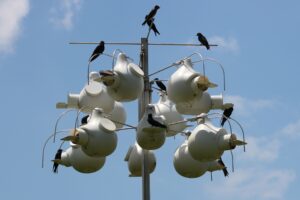By volunteer
 It’s time for some March Madness, and we all know what that means. No, no, no, not basketball; I mean birds. That’s right, birds. Ever lengthening hours of daylight triggers the start of the spring migration season. Many of our winter visitors will soon start heading back north to their summer breeding grounds. Dark-Eyed Juncos, Pine Siskins, White Throated Sparrows, and others will begin to leave the area. Once they depart, we will not see them again until fall.
It’s time for some March Madness, and we all know what that means. No, no, no, not basketball; I mean birds. That’s right, birds. Ever lengthening hours of daylight triggers the start of the spring migration season. Many of our winter visitors will soon start heading back north to their summer breeding grounds. Dark-Eyed Juncos, Pine Siskins, White Throated Sparrows, and others will begin to leave the area. Once they depart, we will not see them again until fall.
As they leave, others will be traveling from farther south to take their place. They will be replaced in our awareness by Indigo Buntings, Chipping Sparrows, Orioles, and others. Some need only travel a few hundred miles, however, one of my favorite summer visitors will need to make a journey of two thousand miles or more!
Purple Martins spend most of the year soaring in the skies over the Amazon River basin. For a bird that eats flying insects, it is a smorgasbord unmatched anywhere. We are lucky our buggy season coincides with their breeding season. Like clockwork, these beautiful birds will begin arriving in our area mid-March. (As of this writing, they are being reported as far north as Tennessee)
It is believed that Native Americans of the eastern woodlands invited these birds into their villages by hanging gourds and other suitable items for nesting. Some people think it was for the natural pest control. I prefer to think it was for the beauty of the music the birds create with their morning song. Either way, Purple Martins in the eastern half of the U.S. have become nearly 100% dependent on humans for housing.
Once they arrive, they will begin the business of building nests, laying eggs, and raising young. It will take 15 to 18 days for eggs to begin hatching after being laid. Then begins the real work. Both parents will make hundreds of trips a day to feed the rapidly growing nestlings. Amazingly, in just 28 days these little birds will be fully fledged and ready to fly!
Last year, between Bernheim’s two colony sites, located near the Education Center and the Edible Garden, our Purple Martins successfully brought over 120 young birds to flight status. Some of these birds may return to Bernheim and raise their own brood in the same area they were born.
At Bernheim Forest, we will be getting our colonies ready for their arrival in the next few days. Timing is crucial to ensure competing species don’t usurp the nest sites. Another part of our responsibility as “landlords” is conducting nest checks throughout the season to ensure the health of the colony. If you happen by while we are there, we invite you to come learn more about these remarkable birds and how you can make a difference in their lives.
–Jim Scout, Volunteer Naturalist

